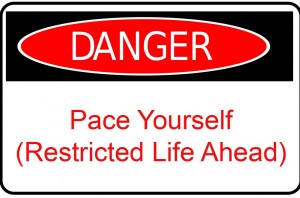Pacing – Does it work?

What is Pacing?
“Pacing is a key strategy to keep ME/CFS symptoms manageable and to lead a consistent lifestyle.” (http://www.mecfs.org.au) At its core it is paying close attention to how you feel and pulling up early to avoid over doing things.
Does Pacing Work?
The answer is yes, but ONLY if the question is: Does Pacing work to manage your symptoms and ensure a consistent (but restricted) life-style.
If however the Question is: Does Pacing make you better? Then the answer unfortunately is very different.
Over the years I have met many people with the idea that they were going to ‘pace’ them self back to full health. But that is unlikely as you are using a technique that is not designed for that goal.
I think it is important to see that avoiding the things that trigger symptoms is not a way to beat CFS. You can avoid exercise (or foods, light, sound, movement, touch, computers, people, going out etc) all together and stop the crashes but have you beaten CFS? That is the difference between managing a condition and beating it. So pacing is designed to manage CFS – so it shouldn’t be a surprise that people will often have to ‘unlearn’ pacing to get well using the Lightning Process.
But before you give up your pacing and just ‘get on with things’ as you may have been told by well-meaning friends, family and health care practitioners – DON’T. If you just stop pacing and push through or ignore symptoms you will crash. You know it. I know it. Every person who has ever suffered from CFS knows it. You have tried that & it doesn’t work.
So please, if you have learnt to pace, then don’t stop. It is a great tool to avoid the ups and downs of CFS & to regain some sort of control over a highly unpredictable condition.
So what could be wrong with something that is working?
In essence Pacing is paying close attention to how you feel and limiting your activity to match. You may hear things like – Listen to your body’s whispers so it doesn’t have to shout. Do half as much as you think you can and no more. Plan for a rest day to follow if you have an activity coming up. This is all good ‘pacing’ advice to avoid the dreaded ( or ‘dangerous’) crash’.
Sounds good until you start to see CFS as involving a dysfunction in the fight or flight response – the brain is already responding to non-dangerous activities as if they are dangerous, producing the PER. Pacing reinforces to the brain that the response IS accurate and the activity IS dangerous. Of course it makes sense it sees it as dangerous because of your past experience. But can we do something about it and break out of the cycle.
The Lightning Process approaches it from a different point of view. The activity is safe but the physical response from your body is inaccurate. So we look to retrain the brain and body to respond appropriately.
This approach is worlds away from ‘avoid the dangerous activities’.
So do we then advocate ‘pushing through’ and ignoring symptoms. Absolutely not – because that doesn’t work. We advocate learning how to change how the body and brain are responding to activities.
One thing that Neuroplasticity teaches us is that the brain is always learning. Every activity, every experience, every thought changes the brain. What is the brain learning when you pace? On a moment-to-moment basis it learns you need to be very careful. Danger is always close-by so pay close attention. That creates an ever-present stressor.
How does this help when you see CFS in terms of the ‘stress response’?
So pacing gives you a ‘safe’ but very restricted life. It’s not even waiting for the first signs of ‘danger’, it is preemptively avoiding danger with generous safety buffers. Good management and that’s all.
Pacing also makes it harder to train yourself out of CFS. One of the other features of CFS is hyper-vigilance (where the brain has learnt to pay very close attention to possible dangers). If it’s dangerous or important enough we will fine tune and develop our senses to detect it really well. What pacing does is to teach a person who already has a brain that is paying very close attention to bodily sensations and trains them to pay even closer attention to bodily sensations. So I would suggest that pacing does nothing to over come hyper-vigilance.
But there is another way other than pacing, pushing through or avoiding things all together………
